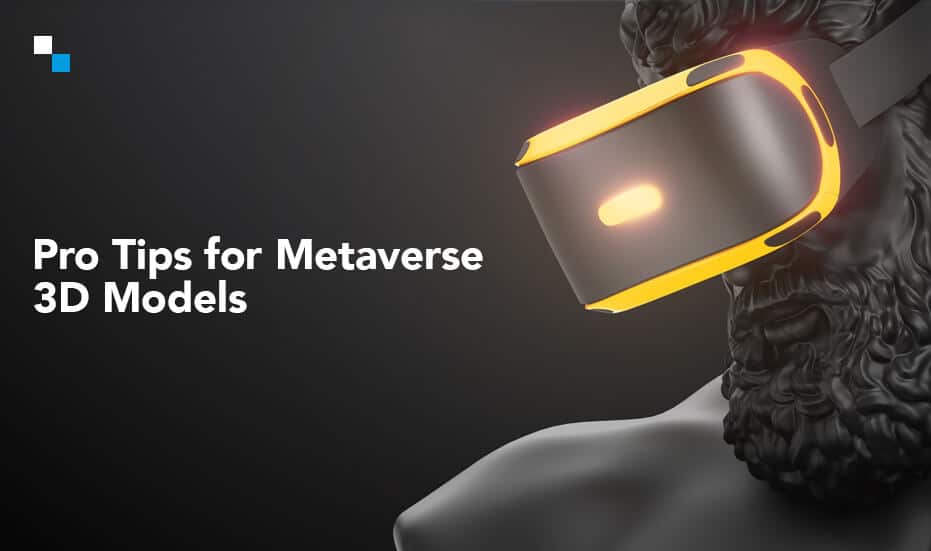
Highlighting Top Reasons to Build SIM Card Integrated Crypto Wallets
May 28, 2024
How To Design An IDO Launchpad On The Binance Smart Chain?
May 29, 2024The Metaverse is rapidly evolving into a captivating world brimming with possibilities. Every object, character, and environment within the Metaverse is constructed from 3D models. These models breathe life into the virtual world, allowing us to explore, interact, and build within it. Without them, the Metaverse would be a blank space devoid of the immersive experiences that will shape its future.
While any 3D model can technically exist in the Metaverse, the quality significantly impacts the user experience. High-performance 3D models are the key to ensuring a smooth, seamless, and enjoyable experience for everyone.
This blog post delves into the world of high-performance 3D modeling for Metaverse development. We’ll equip you with pro tips and techniques to create stunning 3D models that not only look fantastic but also ensure top-notch performance within the Metaverse environment.
Are you ready?
Metaverse Development Essentials: Demystifying 3D Modeling
3D modeling in the Metaverse refers to the process of creating digital representations of objects, characters, and environments specifically designed for use within these virtual worlds. Unlike traditional 3D modeling for games or movies, Metaverse models need to strike a balance between visual fidelity and efficient performance. This means creating models that are detailed enough to be visually appealing but lightweight enough to render smoothly within the constraints of the Metaverse platform.
The scope of 3D modeling for the Metaverse is vast. It encompasses everything from sprawling landscapes and intricate buildings to lifelike avatars and expressive characters. Whether you’re crafting a virtual fashion boutique or designing a fantastical cityscape, your 3D modeling skills will play a crucial role in shaping the user experience.
Key Components of High-Performance 3D Models for Metaverse Development Services
While the artistic vision is crucial, creating a high-performance 3D model for the Metaverse requires careful attention to several components, the major ones are:
1. Geometry
- Polygons: The building blocks of 3D models, polygons define the shape and detail of an object. For Metaverse applications, keeping the polygon count low is essential for smooth performance. We’ll delve deeper into polygon optimization techniques later in the blog post.
- Level-of-Detail (LOD): This technique involves creating multiple versions of a model with varying levels of detail. A high-detail version can be used for close-up views, while a simplified version can be used for distant objects, reducing the overall processing power required.
2. Texturing
- Texturing adds visual richness and detail to your models through the application of textures, which are essentially digital images “painted” onto the surface of the geometry.
- Texture Resolution and Compression: Using textures with lower resolutions and applying appropriate compression techniques can significantly reduce the file size and improve rendering speed.
3. Lighting
- While lighting plays a vital role in creating a visually appealing scene, complex lighting setups can be resource-intensive.
- Techniques like baking lighting information into textures can help achieve realistic lighting effects without impacting performance.
4. Animation
- Animation breathes life into characters and objects within the Metaverse. However, complex animations can be computationally expensive.
- Optimizing animation sequences and leveraging techniques like keyframe animation can help maintain a smooth experience.
By understanding these key components and employing optimization techniques, you can create stunning 3D models that not only enhance the visual appeal of the Metaverse but also ensure a seamless and enjoyable user experience.

#7 Tips for High-Performance 3D Models in Metaverse Development
Pro Tip 1: Start with a Strong Concept and Plan
- Pre-Production Planning:
Building high-performance 3D models for the Metaverse starts long before you dive into the creation software. Solid pre-production planning lays the groundwork for efficient and optimized models. A metaverse development company should maintain clear communication with clients about the model’s purpose and intended use is crucial at this stage.
- Sketching and Concept Art:
Fleshing out your ideas through sketches and concept art helps visualize the final model and identify potential areas for optimization early on. This pre-visualization stage can save valuable time and resources during the modeling process.
- Defining the Purpose and Function of the Model:
Understanding the specific role the 3D model will play within the Metaverse is of utmost importance. Is it a static object in the background, a highly interactive character, or a complex wearable item? Knowing the purpose allows you to tailor the level of detail and functionality for optimal performance within the metaverse environment.
Pro Tip 2: Optimize Geometry for Performance
- Balancing Detail and Efficiency:
The key to high-performance 3D models lies in striking a balance between visual detail and efficient geometry. While intricate details add realism, they also increase the polygon count, impacting rendering speed.
- Techniques for Reducing Polygon Count:
metaverse development services need to implement some essential techniques for optimizing geometry. Here’s how:
- Level of Detail (LOD): Create multiple versions of the model with varying polygon counts. A high-detail version can be used for close-up views, while a simplified version can be used for distant objects, reducing the overall processing power required for smooth rendering.
- Mesh Simplification: Utilize software tools to reduce the polygon count while preserving the overall shape and detail of the model.
- Using Efficient Topology:
The underlying structure of your model, known as topology, plays a significant role in performance. A well-organized topology ensures efficient rendering and animation, leading to a smoother user experience within the Metaverse.
Pro Tip 3: Utilize High-Quality Textures and Materials
- Importance of Texturing in Realism and Performance:
Textures bring your models to life by adding color, detail, and surface features. However, large, unoptimized textures can significantly impact performance. Finding the right balance between visual quality and file size is essential.
- Using UV Mapping Effectively:
UV mapping is the process of unwrapping the 3D model’s surface onto a 2D plane, allowing textures to be applied correctly. For metaverse development services, efficient UV mapping ensures textures are used optimally, minimizing wasted space and improving rendering efficiency.
- Optimizing Texture Resolution:
Here are some strategies for optimizing texture resolution in metaverse environments:
- Texture Atlases: Combine multiple small textures into a single larger texture atlas to reduce the number of individual textures that need to be loaded, improving performance.
- Efficient Use of Normal and Bump Maps: These maps add surface detail without increasing the polygon count. Utilize them strategically to achieve a realistic look without sacrificing performance.
Pro Tip 4: Implement Advanced Lighting Techniques
- Role of Lighting in Enhancing Visual Appeal:
Lighting plays a crucial role in creating a visually appealing and immersive experience within the Metaverse. By strategically using lighting techniques, you can enhance the realism and atmosphere of your 3D models while maintaining performance.
- Techniques for Realistic and Performance-Friendly Lighting:
Here are some key strategies for metaverse development services:
- Baking Light Maps: This process pre-calculates the lighting effects onto the model’s textures, reducing the real-time processing required and freeing up resources for other aspects of the Metaverse experience.
- Dynamic vs. Static Lighting: Use a combination of dynamic lighting for real-time effects and static lighting for pre-baked environments. This approach balances realism with efficiency.
- Using Global Illumination and Ambient Occlusion:
These techniques simulate realistic lighting effects like natural light bouncing off surfaces and subtle shadows. Utilize them strategically to create a believable environment while keeping performance in mind.
Pro Tip 5: Ensure Smooth and Realistic Animations
- Importance of Animation in 3D Models:
Animations bring life to your 3D models, making them more interactive and engaging within the Metaverse. Whether it’s a character walking or an object rotating, smooth animations are essential for a seamless user experience.
- Keyframe Animation vs. Motion Capture:
There are two primary methods for animation:
Keyframe Animation: Artists manually create key poses for the animation, transitioning between them to create movement.
Motion Capture: Real-world movements are recorded and translated into animation data, offering a more realistic look and feel.
- Techniques for Optimizing Animation Performance:
Metaverse development services must consider these optimization techniques:
- Simplifying Rigging: The skeletal structure that controls an animated character can be complex. Optimize the rig by removing unnecessary bones and maintaining a clean hierarchy for efficient animation processing.
- Reducing Bone Count: Keeping the bone count in the rig low helps improve animation performance, especially for large numbers of characters within the Metaverse environment.

Pro Tip 6: Use Effective Tools and Software
- Recommended Software for 3D Modeling:
Several software options cater to creating high-performance 3D models for the Metaverse:
- Blender: This free and open-source software offers a robust set of features for 3D modeling, animation, texturing, and rendering. It’s a popular choice because of its wide range of capabilities and active development community.
- Autodesk Maya: This industry-standard software provides a powerful and professional set of tools for 3D modeling, animation, simulation, and rendering. While commercially licensed, it allows the creation of high-quality assets specifically designed for metaverse development services.
- 3ds Max: Another powerful option from Autodesk, 3ds Max is known for its extensive toolset for 3D modeling, animation, and rendering. It caters well to professional game and animation pipelines, making it a strong choice for creating optimized assets for the Metaverse.
- Utilizing Plugins and Extensions for Enhanced Functionality:
Many 3D modeling software programs offer plugins and extensions that can further enhance your workflow and optimization capabilities. Look for plugins that address specific needs like polygon reduction, texture baking, or animation optimization.
- Importance of Staying Updated with Latest Tools and Trends:
The world of 3D modeling and metaverse development is constantly evolving. Stay updated on the latest software versions, industry trends, and optimization techniques to ensure your skills and tools remain cutting-edge for delivering high-performance 3D models in metaverse development services.
Pro Tip 7: Test and Optimize for Different Platforms
- Ensuring Compatibility Across Various Devices:
The Metaverse aims to be accessible across diverse devices and platforms. Therefore, it’s crucial to test your 3D models on various hardware and software configurations to ensure compatibility and smooth performance.
- Techniques for Performance Testing:
Here are some approaches to test performance in the context of your metaverse development services:
- Stress Testing: Push your models beyond their expected usage to identify potential bottlenecks that could impact user experience.
- User Feedback and Iterative Improvement: Get user feedback on the performance of your models within the Metaverse environment. Use this feedback to identify areas for improvement and make iterative optimizations.
- Tools for Profiling and Optimization:
Several profiling tools analyze the performance of your 3D models within the Metaverse platform. These tools pinpoint areas causing performance issues, allowing you to identify and address optimization opportunities.
How Antier Can Help?
By implementing these pro tips and continuously honing your skills, you’ll be well on your way to crafting high-performance 3D models that not only enhance the visual appeal of your Metaverse development but also contribute to a seamless and enjoyable user experience. As the Metaverse continues to evolve, your mastery of high-performance 3D modeling will position you at the forefront of building immersive and engaging virtual worlds.
Antier, a leading metaverse development company, understands the importance of high-performance 3D models for successful services. Our team of skilled 3D modelers and expert metaverse developers possess the expertise to guide you through the entire process. From concept ideation and optimization techniques to integration within various metaverse platforms, we can help you bring your vision to life while ensuring exceptional performance.
Don’t let performance hold you back. Let Antier craft high-performance 3D models for your Metaverse experience!



